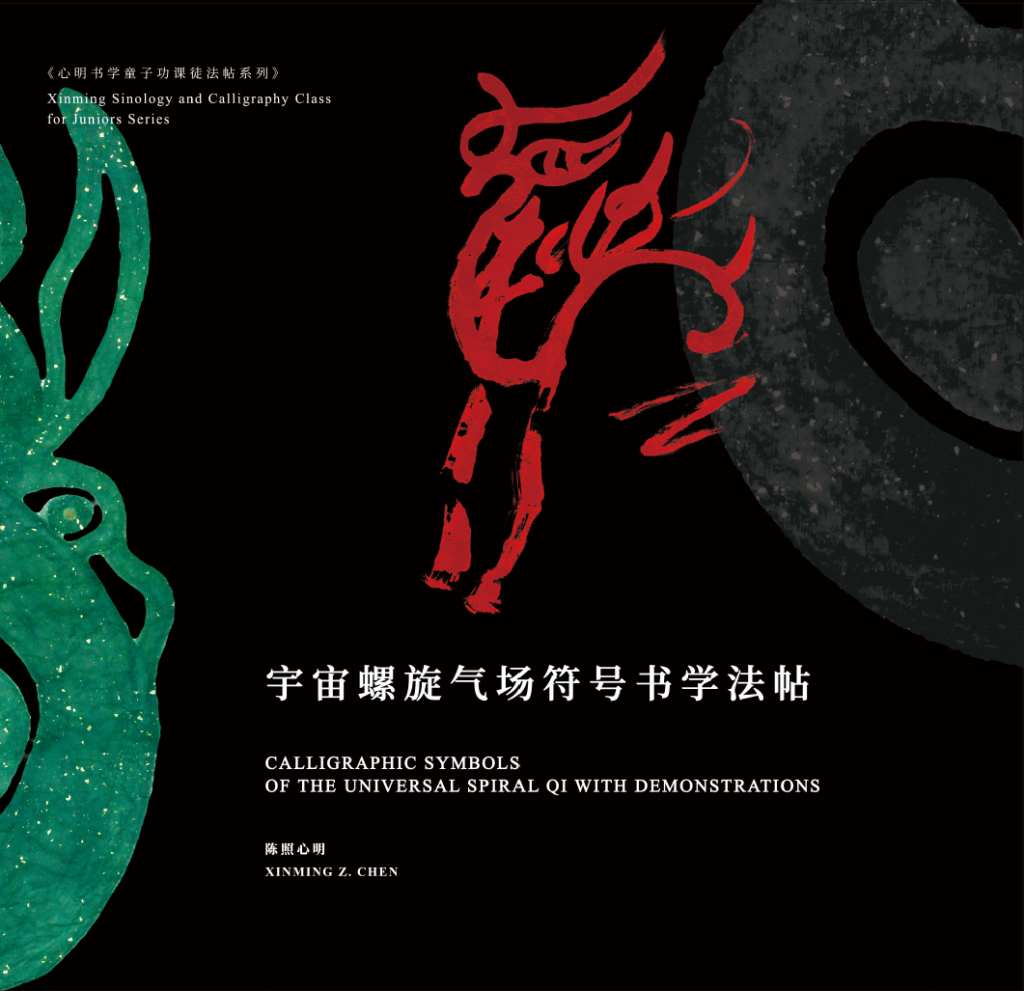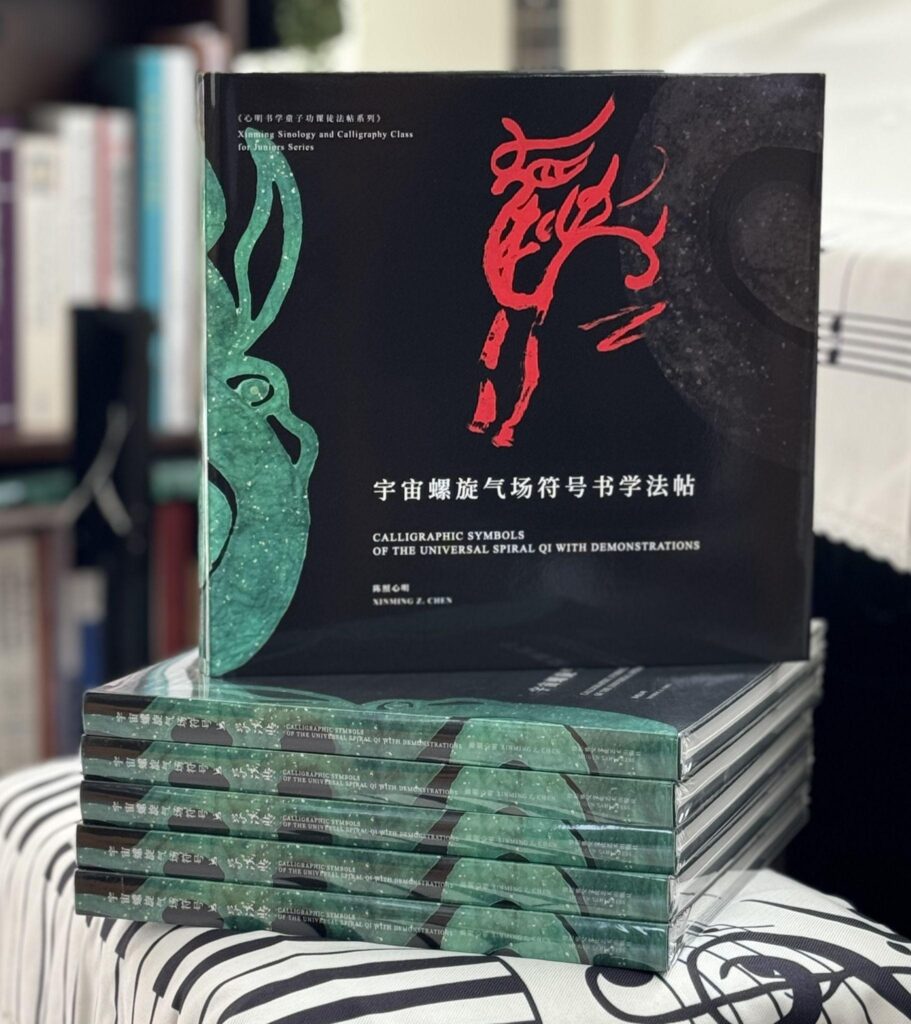escort şişli nişantaşı escort bayan mecidiyeköy escort hulya şişli escort duru mecidiyeköy escort meltem mecidiyeköy escort defne mecidiyeköy escort yaren mecidiyeköy escort deniz escort bayan mecidiyeköy escort ferda mecidiyeköy şişli escort pelin vip escort sınırsız escort grup escort mecidiyeköy escort sıla mecidiyeköy escort ezgi escort istanbul
新书发布《宇宙螺旋气场符号书学法帖》
NEW PUBLICATION
Calligraphic Symbols of the Universal Spiral Qi with Demonstrations
by Xinming Z. Chen
刘羽西 Ken Liu
新西兰母根雅父文化艺术出版社 社长
New Zealand Mugen TAHI Press – Director
心明师的新书《宇宙螺旋气场符号书学法帖》于2024年1月正式出版发行。发行以来受到社会文化界,学术界以及教育界的一致好评。作为出版此书的出版社母根雅父文化艺术出版社的社长,我很欣慰能够担当此重任,并拉开了心明师文脉传承的序幕,为千年书法源流的传承与教学系列丛书的出版翻开了精彩的第一页。
Xinming’s new book was officially published in January 2024, and it was well-received and warmly welcomed by peers and major practitioners in this field. As the publisher, we are delighted to see such reactions from the market, and we are also happy to see a good headstart of the series that to be published in the years to come.

初入子玄草堂的时候已经是十多年前的事情了。我当时被心明师的艺术作品深深震撼,进而拜入门下成为草堂弟子。新西兰子玄草堂由子玄师和心明师二贤创立,继承了传统书院式的教学体系,从书学入手,以金石书画学派的理论为根基,将中国思想史、艺术史及文化史理论高度融合,并深入浅出的教授给学生。心明师经过多年的研究及教学实践,追源溯本,将书学的源流从甲骨文向前推到宇宙螺旋气场符号,并结合了远古岩陶图形开创了“符号书”,同时还将符号书融合在书学启蒙的教学中, 开创了中国书学入门之法的新里程碑。
It was more than a decade ago when I first came to The Art and Humanity Institute (TAHI) where I got utterly amazed by Master Xinming’s artwork and decided to become a student.
TAHI was created by Master Zixuan and Master Xinming, and it has adopted the pedagogy of a traditional Chinese academy, based on the theories of the Jin Shi Shu Hua School. It starts its teaching via Chinese calligraphy, imparting to students the combination and concentration of
the histories of Chinese thoughts, art and culture. After decades of research and empirical experience accumulated from teaching, Master Xinming traced back the root of Chinese calligraphy from oracle bones to the calligraphic symbols of the universal spiral qi, and she ingeniously employed them in the introduction of calligraphy study, setting a new milestone!
翻译并出版心明师的著作是殊荣也是压力。尽管我已跟随心明师浸习多年对恩师的初心和理论体系也有所了解,然而将如此深厚的‘功力’翻译成英文,且要达意优美,也着实令我紧张了许久。然功夫不负有心人,经过近两年的准备,这本《宇宙螺旋气场符号书学法帖》终于翻译出版,并得到恩师的认可,也算弟子没有辜负厚望。这本书同时也是心明师书学大脚印系列丛书英译本的开局,接下来还会有《金石书画学派在海外的传承》、《心明书学大脚印2印论文与作品集》、《心明书学童子功法帖》、《陈照心明临古法帖精选》及《心明文集》等等精彩的著作逐一发布,将心明师30年的研究、教学及创作成果娓娓道来,也必将对金石书画学派在海外的传承产生深远影响。一转眼我已人到中年,在草堂的日子一路走来,觥筹茶盏带墨香,曼陀罗花悟笔道。我从一个对中国文化历史及艺术一知半解的青年人一步一步扎实研学修心修行,并慢慢摸到了成为儒生的门径。而今我8岁的大女儿小星儿也开始在草堂学习,蒙学问门,变得知书,达礼;每次回到草堂,都有种恍如隔世的亲切与宁静。
Translating Master Xinming’s works is an honour and a burden. Despite years of studying and a good understanding of her theories and findings, it still makes me nervous and humbles me even thinking of the attempt to translate such “rich deposit” into English with the accuracy and elegance it deserves. However, after two years of collective hard work, this book was finally translated and published, and I hope it didn’t fall short of the expectations. This book is also the first of a number of English publications of Master Xinming’s works, such as ‘The Inheritance of Jinshi Calligraphy School Practices Overseas’, ‘Xinming Sinological Studies and Big Footprints II – Essays and Portfolios’, ‘Xinming Sinology and Calligraphy Class for Juniors – Model Works’, ‘Xinming Zhao Chen Copying Ancient Model Calligraphic Works – Selected Works’, ‘Xinming Collectanea’ and more, revealing the findings and achievements of Master Xinming in the last three decades. These publications will wield enormous influence in the study of Chinese calligraphy overseas.
Time travels fast and with a blink of an eye, I am no longer the young man I used to know. Looking back at my days here at TAHI, I have transformed from a green-handed and inexperienced boy with some superficial knowledge, to a humbled scholar who commits to actions and internal cultivation. My 8-year-old daughter Victoria is also learning with Master Xinming, though starting early, she has already demonstrated the desirable nature of a cultivated soul. Every time I come back to TAHI, I feel like coming back home, warm and quiet.

十几年转瞬,笔下的文字如何能写尽恩师慈悲的阳光雨露,润物无声的言传身教,孜孜不倦的谆谆教诲。相信这本《宇宙螺旋气场符号书学法帖》会影响到更多的人,让子玄草堂的这份对人文对生命认真的精神得以花开天下!
Words fail me when I try to depict the compassions of Master Xinming and Master Zixuan, their tender and constant guidance, and their assiduous and patient teachings. This book will influence more. It is an announcement to the world of what TAHI stands for!
新书反馈选编
Selected reviews from peers and readers:
德庆央宗:
“很佩服心明师对中国传统文化研究和传播的坚持;很欣赏您和心明师对经典国学的研究底蕴,我们正在建立一个数字化平台,将来会是一个国际化面向全球传播中华文化途径,一定会为您提供一席之地,让心明师的心血发扬光大。”
德庆央宗是中国国务院发展研究中心的首席专家,国家文化教育发展纲要的智库组成员。提出‘国际视野 创新思维 人本规划 个性发展’的人才发展观。在推动教育科技人才良性循环,传承中华优秀传统文化的创新基因,营造鼓励探索、宽容失败的良好环境中,做出了贡献。
Deqing Yangzong:
“I deeply admire Master Xinming’s persistence in researching and promoting traditional Chinese culture. I truly appreciate the profound knowledge that both you and Master Xinming possess in classical Chinese studies. We are currently building a digital platform that will become a global channel for spreading Chinese culture internationally. You will undoubtedly have a place in it, allowing Master Xinming’s dedication to flourish and gain recognition worldwide.”
Deqing Yangzong is the chief expert at the Development Research Center of the State Council of China and a member of the think tank group for the National Cultural and Educational Development Program. She has proposed a talent development philosophy focused on “global vision, innovative thinking, human-centered planning, and personalized development.” She has contributed to creating a positive cycle in education, technology, and talent development, while fostering the innovative essence of traditional Chinese culture and building an environment that encourages exploration and tolerates failure.
周正:
“中国文字的重要来源就是原始图画,所谓“仰观俯察”“因俪鸟龟之迹,遂定书字之形”,盖多“象形”以形成初文,而后以“会意”“形声”等方式孳乳成字。中国传统的文人书画家又特别讲求“书画同源”,赵孟頫诗云:“石如飞白木如籀,写竹还应八法通。若也有人能会此,须知书画本来同。”观看上古图画、刻符、纹样,总会有神秘瑰奇的感觉。这种高古的审美,也是中国书法艺术的一贯追求。以教学而言,运用这些符号,既能起到激发学习兴趣的效果,又能满足“取法乎上”的要求,且因其用笔的简单纯一,能够更有效率地引导初学者掌握书法用笔原理。“结字因时相传,用笔千古不易”,惟有优先掌握篆籀式的用笔,才能在书法领域取得长足的进展。陈照心明老师的书学法帖,立意既明,取法复高,在富于趣味的基础上,着重解决书法学习中的主要矛盾,教授法可称精善。书后书学法帖表中只是以古今文字书写符号名称,如能从经典书迹书作中撷取与该符号神采内蕴相通相近的字例加以补充,或将对学习者更有裨益。”
周正是北师大艺术传媒学院书法专业博士。
Zhou Zheng:
“The origins of Chinese characters lie in primitive pictograms. The concept of ‘observing the heavens above and examining the earth below’ suggests that characters were formed from imitating patterns such as bird and turtle tracks, with many characters originally being pictographic. Over time, these evolved through methods like ideographs and phonetic compounds. Traditional Chinese scholars and painters often emphasise the principle of ‘the shared origin of calligraphy and painting.’ Zhao Mengfu wrote in a poem: ‘Rocks resemble the flying-white script, trees resemble the ancient seal script; to paint bamboo, one must understand the eight principles of brush strokes. Those who grasp this realise that calligraphy and painting are fundamentally the same.
Viewing ancient paintings, carved symbols, and patterns evokes a sense of mystery and beauty. This pursuit of ancient aesthetics has always been a goal in Chinese calligraphy. In teaching, utilizing these symbols can spark interest in learners, meet the high standards of ‘taking the law from the highest,’ and, because of the simplicity and purity of their brushwork, efficiently guide beginners to grasp the principles of calligraphy. ‘The structure of characters changes with the times, but brush techniques remain eternal.’ Only by mastering the brush techniques of seal and ancient scripts can one make significant progress in calligraphy.
Master Chen Zhaoxinming’s calligraphy model books are clear in their intent and draw from high standards. While maintaining a sense of fun, they address key challenges in calligraphy learning. His teaching methods are sophisticated and effective. The annotations at the end of the book, which list names of symbols from ancient and modern scripts, could benefit further by including corresponding examples from classical calligraphic works that reflect the spirit and essence of these symbols.”
Zhou Zheng holds a doctorate in calligraphy from the School of Arts and Media at Beijing Normal University.
楼可程:
“心明、子玄女史好,大作收阅,直追上古,可谓穷流溯源,可敬可佩。”
楼可程是浙江大学艺术与考古博物馆馆长。
Lou Kecheng:
“Greetings, Xinming and Zixuan. I have received your masterpiece, which traces the origins of ancient traditions. It can be described as delving into the source of the river’s flow—a truly admirable effort.”
Lou Kecheng is the director of the Art and Archaeology Museum at Zhejiang University.
熊螢:
“10年前,我有幸在新西兰遇见“子 玄 草 堂 ”,得知心明师30年来孜孜不倦的从事书画研究和创作,并教授孩子们学习中国文化和书画,从未间断。老师对中国文化和书法的坚守与传承, 让我为之动容。做为母亲,心生一愿,愿为中国的孩子们求得书画学习的心法,此愿终于在8年后得偿,拜入师门开启书画学习之门。
深入学习后方知,中国书法根深道长,师祖是一代宗匠李瑞清先生(清道人),三千年书学了然于心,各体皆通,师祖提倡:“学书要神游三代,涵泳秦汉,纳篆入碑,纳碑入帖”。心明师几十年来沿着祖师的脚印,传承师门心法,经多年潜心研究大胆提出:“学书应从宇宙螺旋 气场符号入门。”并将心得著述于今年出版的《宇宙螺旋气场符号书学法帖》。
书中例举了螺旋气场符号从上古三皇至今无处不在。“篆者,传也,引文也”,老师承袭“取法乎上”的书法传统,把这些发现一一请出来,用全新编辑手段、设计技巧进行诠释,以易于学习的面貌呈现给学习者,此书一经发表,北京草堂的弟子们如获珍宝,明白了中国书法的始源, 是与文字本身的产生同样古远的。孩子们不再孤立地一笔一画呆练,书法学习有了根气、有了千年的链接。
心明师从笔法、结构、文字学启蒙循序渐进地把书法置于中国传统文化与美学的训练当中,渐至笔墨润泽,德艺俱美之境。
笔下见人,笔下见心,跟师学习数载更加坚定心明师所言:“学书是学明心见性,是修身进德的好法门。”
熊螢是北京学堂校长, 北京金阳朗月行走学堂。
Xiong Ying:
“Ten years ago, I was fortunate to encounter ‘Zixuan Cottage’ in New Zealand, where I learned about Master Xinming’s thirty-year-long commitment to the study, creation, and teaching of Chinese painting and calligraphy. Her dedication has been unwavering. Master Xinming’s perseverance in upholding and passing on Chinese culture and calligraphy has deeply moved me.
As a mother, I had a wish for my children to find a method for learning calligraphy and painting. Eight years later, that wish came true when I became a disciple of the master and began my journey in calligraphy and painting。
Through in-depth study, I realised how deeply rooted Chinese calligraphy is. Our master’s lineage traces back to Li Ruiqing (Qing Dao Ren), a master calligrapher of the late Qing dynasty. With a thorough understanding of three millennia of calligraphic tradition, the master was proficient in all scripts. He advocated for ‘exploring the essence of three ancient dynasties, immersing oneself in the Qin and Han, integrating seal script with stone inscriptions, and inscriptions with model books.’
Following in the master’s footsteps, Master Xinming has carried forward the teachings of the lineage. After years of focused research, he boldly proposed that ‘the study of calligraphy should begin with the cosmic spiral energy field symbols.’ This insight is documented in her newly published book.
The book illustrates how these spiral energy field symbols have existed from the Three Sovereigns of ancient times to the present day. As the saying goes, ‘Seal script represents transmission and citation.’ Master Xinming has followed the tradition of ‘taking the law from the highest’ in calligraphy, presenting these discoveries through innovative editorial and design methods, making them accessible to learners. Once published, disciples at the Beijing school treasured the book, understanding that the origins of Chinese calligraphy are as ancient as the origin of writing itself.
With the guidance from this book, children no longer practice mindlessly, stroke by stroke. Instead, their study of calligraphy is now rooted in tradition, connected to a legacy thousands of years old.
Master Xinming gradually integrates calligraphy into the broader training of Chinese culture and aesthetics through the study of brushwork, structure, and philology. The learning process eventually leads to a harmonious balance of skill and virtue. As the saying goes, ‘The brush reveals the personality and the brush reveals the heart.’ After years of following the master, I have come to firmly believe in her words: ‘The study of calligraphy is the study of self-awareness and self-cultivation—it is a good path to personal growth and moral development.’”
Xiong Ying is the headmaster of a school in Beijing. Beijing Golden Sun Bright Moon Walking School.
朱文奇:
“今天看到了姐姐的大作,十分赞叹。姐姐是研究的螺旋气场,字写得非常有功力,自然古朴,是中国古代的书法与侨居所在地的艺术结合的产物,十分精彩。螺旋气场现在在世界范围内,鲜有人研究。作者从古代遗迹中发掘的纹样,来证实这样的证据,着实不易。特别说一句,作者的书法,透露出一种前所未见的,中国人遗失了的一份高古的气质。研究原始艺术,是世界共通的,可以打开和世界交流的窗户。”
朱文奇- 毕业于北京工业大学建筑系,他的设计曾经获奖。自幼喜欢书画,是收藏家协会会员。
Zhu Wenqi:
“Today, I had the pleasure of reading my sister’s work and was deeply impressed. My sister studies spiral energy fields, and her calligraphy is highly accomplished—natural and unpretentious. It beautifully combines ancient Chinese calligraphy with the artistic influence of her adopted homeland, making it truly remarkable.
Currently, few people in the world study spiral energy fields. The author has unearthed patterns from ancient relics to validate her findings, which is no easy task. I must also say that her calligraphy reveals a rare, ancient quality—a high aesthetic that seems to have been lost among the Chinese people. Researching primitive art offers a universal language that can open windows for dialogue with the world.”
Graduated from the Architecture Department of Beijing University of Technology, his designs have won awards. He has been passionate about calligraphy and painting since childhood and is a member of the Collectors’ Association.
